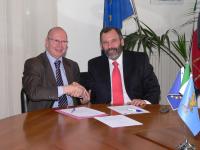Antarctic Seismology
The twenty-year-long agreement on scientific collaboration endorsed between OGS and the Direccion Nacional del Antartico – Instituto Antartico Argentino (DNA / IAA) has been renewed for another 5 years.
Dr. Mariano Memolli, Director of the Direccion Nacional del Antarctico, the institution entrusted by the government of Argentina with the responsibility of managing the Argentinian bases and the scientific activity in Antarctica visited OGS on Thursday, July 28th, 2011. At OGS he met the President, Prof. Iginio Marson, Prof. Franco Bertazzi, member of the Board of Directors, the Directors of the OGS's departments and a group of researchers involved in polar studies.
During the short presentation of the activities of DNA and of its purely scientific arm, the Argentine Antarctic Institute, Dr. Memolli paid particular attention to the results of the Argentinian-Italian Antarctic Seismographic Network (ASAIN) which dates back to January 20, 1992. On that date, ASAIN became operational at the Argentinian base Esperanza, the first of seven seismographic stations (5 in Antarctica and 2 in Tierra del Fuego) that transmit real-time seismograms to OGS, DNA and other international seismological centers.
As the ASAIN project manager Dr. Marino Russi from OGS explained, the Italian Programma Nazionale di Ricerche in Antartide has recently confirmed its financial support to the scientific program dealing with the development of the network, including a visit to the field installations by OGS technicians during the next Antarctic campaign, to check the efficiency of instrumention. Closing his speech, Dr. Memolli remarked that the “youngest” ASAIN station, activated on January 16, 2009, at Belgrano II Base, 1300 km from the South Pole, was of particular importance in the framework of the activities of the network due to its operational continuity, the quality of the recorded seismograms, and the fact that it is the southernmost seismographic station in the Antarctic, where the seismometer still rests directly on rocky ground although surrounded by the ice of the polar cap.

